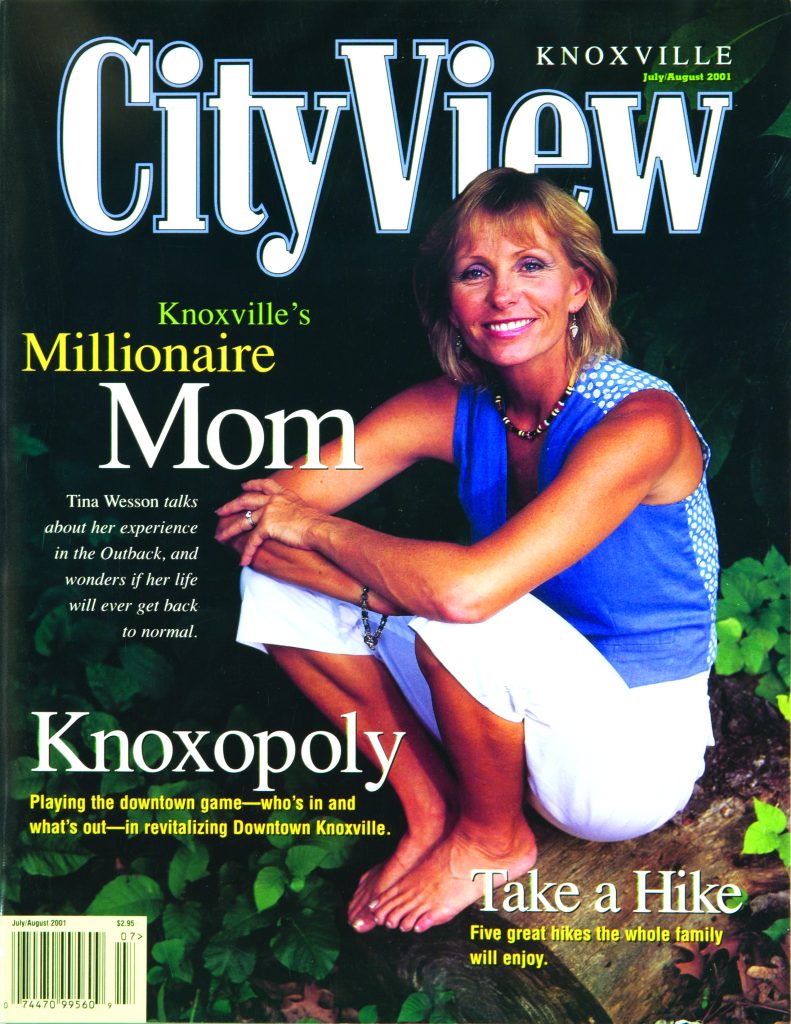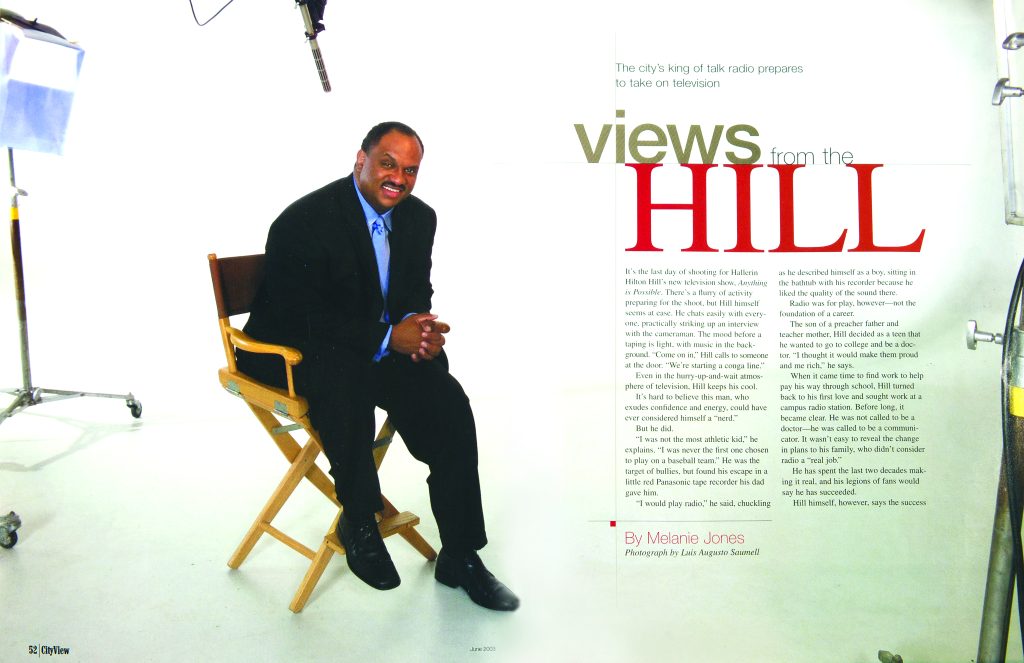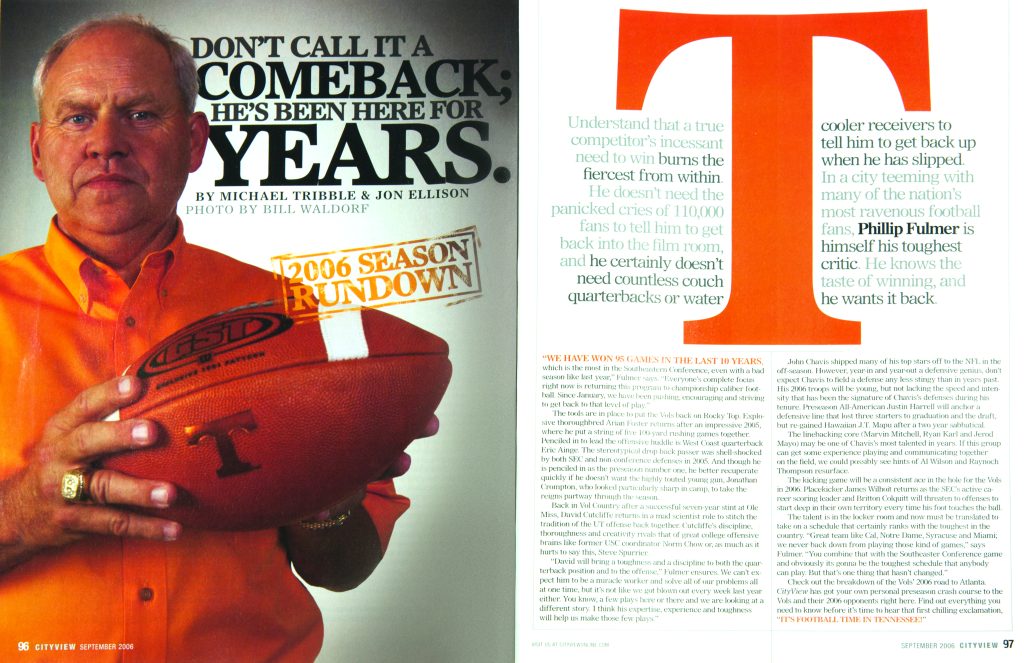For our 30th anniversary, then-Managing Editor Sarah H. Clark did a very thorough retrospective on Cityview’s history in our January 2014 issue. Those were the days before Cityview’s modern website, and though you can still read the 30th anniversary article in the digital flipbook on our archives, it—like many of our older articles—never made it to our online blogs. Now, as we look forward to our 40th anniversary, we thought we’d once again share her look back on how we came to be here. We hope you’ll find the story as engaging as we did.
–Micha Haas, Managing Editor
“Print is Dead! Print is Dead!!!”
Cityview—Knoxville’s longest standing—and only—independent, local, editorially based magazine, begs to differ. A few concessions may have to be made to progress here and there (check out our new website at www.cityviewmag.com!), but we believe that, at least for the time being, there is still a significant and compelling—and we hope sometimes provocative—role for a city magazine to play in the life of this town.
Our 2014 Top Entrepreneurs profiles offer shining examples of Knoxville’s business spirit. Indeed, after more than 200 years, Knoxville remains a place with an overwhelming sense of possibility and progress. And so much good is yet to come.
This is the spirit and the ethos that Cityview has highlighted and celebrated since its founding in 1984. Perhaps it is this connection to Knoxville’s indomitable spirit that has kept Cityview alive. All we know is, though other magazines have come and gone over the decades, Cityview is still surviving and thriving after 30 years of print—in Knoxville, Tennessee.
The Early Days (1984-2000)
The idea that became Cityview magazine began not with a spark—but with a full-fledged fire. Specifically, it was the fire that completely destroyed the building that housed Dale Insulation, a company run by John and Nancy Lyle, as well as six other businesses, in 1983. The arsonist was caught, and the fire received a great deal of attention in both print and television news.

However, Dale Insulation managed to keep its figurative doors open through help from its parent company in Nashville, warehouse space donated by local grocery store chain H.T. Hackney, and rapid shipment of new inventory from supplier Owens Corning—only to find that their competitors were stealing Dale’s customers, who didn’t know Dale was still open.
“There was a real need to tell our story,” says John Lyle. He and his wife Nancy ultimately decided to tell it themselves. They published a short magazine called The Home Living Guide and mailed it to 40,000 homes around Knoxville. “We told the story about what we were doing and what we were trying to accomplish,” says Lyle. They also sold profiles to several other home-related businesses in town.
Much to the Lyles’ surprise, their magazine was very popular—and more and more businesses were calling them and asking to be included. These were not only home improvement-related businesses, but banks, nail salons, and more. “And it worked,” says Nancy. “The advertorials got response.” They decided to continue to publish, changing the magazine’s name to Cityview.
“We found that a lot of people wanted to tell their story—not just what they did, but why they did it, and what made it different,” says John.
Nancy Lyle had some experience in media sales, and she took over running Cityview for much of the 17 years that the Lyles owned it. The magazine ran strictly advertorial pieces and published between four and six times a year. “Nearly every business that we went to had a story, and it was a story that would be hard to tell in a display ad or a 30-second spot on the radio,” says John.
It seemed, many businesses were interested in telling that story to the Knoxville public. “Literally overnight, we had big advertisers calling us for spots,” says John. “Sometimes the cover would be sold out for a year or two in advance,” adds Nancy. As the magazine grew more successful, the Lyles knew they needed to either take Cityview to the next level or sell it to someone who could. After 17 years, the couple decided it was time to move on and accepted an offer to sell.

A New Beginning (2001)
In late 2000, Cityview’s current publisher Nathan Sparks purchased Cityview Publishing from Betty Lue Sharp. Sharp had been struggling to keep the company afloat since she had bought it less than a year before, and she agreed to stay on as marketing director if Sparks would buy the business and help her to make it profitable. Sparks, who was currently juggling ventures in mortgages, banking, and mergers and acquisitions, agreed. “I thought it would be a nice side venture,” he says. His plan was to get the company back in shape—and then sell it to someone who would run it in the long term.
But things didn’t work out quite as planned. In early 2001, Sparks published his first issue with the tagline “The Business and Community Connection.” This January/February issue ran for just 28 pages, mostly profiling businesses and with a spotlight on the new Gibbs Center on Tazewell Pike. “Trying to learn how to be part of the media and to be a publisher was a whirlwind—it could sometimes be quite overwhelming,” says Sparks.
The next issue began the process of transforming Cityview from an advertorial magazine featuring all-paid content to a true editorial magazine driven by the publisher and editors. The Spring issue’s nameplate read simply Knoxville Cityview. Sparks says he had begun to form the vision of a magazine “that would emphasize all that was good in the community.” Though he had had no real idea of how the magazine would run when he bought it, two issues were enough to give him an idea of where he wanted the publication to go—and that he wanted to remain a part of the magazine for more than just a few months.
“I had always heard that in order to be successful in the media, you had to cover what was negative—and I just didn’t believe that. I wanted people to have something they could enjoy and look forward to, instead of one more rag out there full of stories about terrible things,” says Sparks. But it was also at that point that “I realized that I truly had no idea what I was doing,” he says.
Sparks began to look for a mentor, someone who could teach him about how to be a responsible, positive member of Knoxville’s media community. He found that mentor in Johnny Pirkle, a longtime friend of his—and the owner of two FM radio stations, WOKI 100.3 and WTNZ 94.3. He called Pirkle and asked if he could help to get Cityview on the right track. “[Pirkle] began to help me understand how to properly conduct an interview, how to research before an interview, and so much more,” says Sparks.
The first issue that the two worked on together was July/August 2001, featuring local Survivor winner Tina Wesson.
The September 2001 issue was a real turning point for Cityview. The latest breaking scandal at the time was the relationship between University of Tennessee employee Pamela Reed and then-university president Wade Gilley. “We had published a small cartoon [by Alexei Chtykhine] in the July/August issue of Pamela Reed sitting at a computer writing love letters to Gilley as a preview of our coverage to come,” says Sparks. The caption read, “As the old saying goes, ‘Don’t mix business with pleasure.’ We look into the aftermath of the Pam Reed and Wade Gilley situation.”
Shortly thereafter, as he and Pirkle were sitting in the Cityview office one afternoon, they received a phone call from Reed. At the time, the only member of the media who had been able to speak with Reed was WATE TV evening anchor Lori Tucker—who also happened to be the subject of an article slated for the September issue of Cityview. “Reed called me every name you could think of, and said the media were all low-lifes and schmucks for the abuse they were laying on her for what she maintained was her personal life,” says Sparks. He countered by offering her an outlet to present her own side of the story. She agreed.
The resulting interview, which featured photos of Reed dressed in angelic white and seductive red—and which disclosed the name of the individual who had hacked into Reed’s computer server and revealed the emails between Reed and President Gilley—took Knoxville by storm. “This issue was the talk of the town,” says Sparks. “For ten days, I don’t think there was anybody who didn’t know what Cityview was or who wasn’t trying to get their hands on an issue.”
As Cityview continued to delve into all that was Knoxville and find its legs as an editorially focused city magazine, Johnny Pirkle encouraged Nathan Sparks to tackle all aspects of city life—and to seek out the people Knoxvillians really wanted to read about. One of these was Tina Wesson, “Knoxville’s Millionaire Mom” and winner of the second season of the new smash hit show Survivor. In what would become Cityview’s signature style, the interview included not only questions about Wesson’s time on national television, but also focused on her Knoxville background and upbringing.
“I think it was the first real interview she’d given the media after she won. So we felt like it was a real editorial scoop,” says Sparks. The Cityview team ran Wesson to ground outside of her church on Middlebrook Pike and convinced her to give them a few minutes. They photographed her on a fallen oak log behind the building—which was also surrounded by a field of poison ivy. “It seemed fitting for her,” says Sparks.

September 2001 also saw the beginning of Cityview’s political coverage. “We interviewed Mayor Victor Ashe about his accomplishments, his problems, and the News Sentinel land-swap,” says Sparks. After securing the interview, Sparks prepared a list of questions and purchased a new tape recorder, with a microphone and stand, to record his interview with the mayor. The experience was his introduction into the world of Knoxville’s back-door politics. Pirkle had told him, “Don’t worry too much if the recorder doesn’t work. They’ll give you a copy of the interview.”
“I was thinking, ‘That’s so not true. The mayor of Knoxville isn’t recording his interviews with the media. Why would he do that?’” says Sparks. Yet when Ashe entered the conference room where Sparks was waiting, the two shook hands—and then Ashe rapped his knuckles on the top of the recorder, hard. “Is this working?” he asked. “I said, ‘Well, it was,’” says Sparks. “And then—and I’ll never forget this—he said, ‘Well, don’t worry. If it doesn’t work, I’ll give you a copy of the recording.’ I was stunned.” Sure enough, the mayor’s office later provided Sparks with a transcript of their conversation.
The interview also caught Mayor Ashe in a lie—he assured Sparks on the record that he had offered the News Sentinel no tax deals in the land swap deal with Eagle Distributing. “Shortly afterwards, we received copies of letters signed by both he and Bruce Hartman—and all the tax abatements were in place,” says Sparks. In fact, the tax incentives Ashe offered the newspaper amounted to around $40 million—while property taxes in the city were subsequently raised to cover the resulting shortage. Cityview broke this story in its November 2001 issue.
True City Magazine (2002-2004)
As Nathan Sparks stepped into his second year as the publisher of Cityview, the magazine continued to grow—and to expand its range of coverage. “The country was just beginning to recover from the September 11 attacks,” says Sparks. Cityview had a part to play in reminding our city that though the Twin Towers had fallen, Knoxville still stood strong.
The Cityview team reached out to local politicians, artists, athletes, chefs, media figures, and more. Cityview’s goal was simple: To showcase Knoxville’s best and brightest, its most interesting people, places, and events.
In June 2003, the magazine featured a cover story on local radio talk show host Hallerin Hilton Hill and his new television show Everything is Possible, which had debuted on May 4 of that year. “I’m an amalgamation of opportunities that have come my way and people who have supported me,” Hill told writer Melanie Jones.
Of course, city magazines cover a wide, eclectic variety of subjects, and Cityview was no exception. That same issue also included articles on local authors Richard Yancey, Lisa Horstman, and Jack Mauro; a guide to the best whitewater rapids in East Tennessee; and a practical piece on helping to reduce childhood obesity with tips from local Knoxville experts. As the years went by, the magazine stepped ever more firmly into its place as Knoxville’s premier independent, editorially driven city magazine.

Beneath the Surface (2005-2007)
Sometimes it’s a little too easy to focus on what we already know about people—and places. As the magazine continued to grow and mature, the Cityview team knew they couldn’t just stay on the surface of what our town and her citizens were all about.
So when Cityview scored an interview with Lady Vols basketball sensation Candace Parker, they didn’t stop—or start—with just her basketball career. “I think women’s basketball is at a point where it can go forward and grow more than it already has—and I feel like in some sense the baton is being passed to our generation, and it is our job to embrace it,” Parker revealed to the magazine. Bill Waldorf’s photography also showed her feminine side in a stunning evening gown—even though she still posed at Stokely Athletic Center.

A New Look (2008-2009)
Years go by and the times change—and so do print aesthetics. Cityview’s look had been evolving throughout the years, but in 2008, the nation had moved solidly into the 21st century, and the team knew it was time to rethink the Cityview image.
Creative Director Shayne Ivy and Cityview began producing magazines with simple, striking pictures on the cover and clean lines and roomy visuals inside. Gone were the flurry of cover lines that appealed to any and every taste with the magazine’s eclectic article offerings. Instead, a single image remained to lure in a reader and capture his or her attention. The magazine’s tagline became “Artful Dialogue,” but its focus remained the same: finding the best stories in Knoxville and bringing them to the city’s citizens.
The February 2008 issue featured a cover model wearing black stiletto boots with a skyscraper molded into the side on a white background. Inside, the cover story was illustrated by a row of heels, boots, tennis shoes, and loafers: Knoxville’s entrepreneurs were still “Standing Strong in Some Big Shoes” despite the country’s rapidly falling economy.
But though 2008 was a bad year for the economy throughout the nation, Knoxville wasn’t hit as hard as many larger cities. Nevertheless, it was also at this time that Cityview reduced its yearly run from 12 issues to six, making it a bimonthly magazine by the end of the year. Though publishing less frequently, the Cityview staff still wanted to give Knoxvillians something to look forward to with every issue—and they redoubled efforts to present exciting stories and beautiful photography on the new schedule.
Along with this change came new issue themes, including education, entrepreneurship, and arts and entertainment. Cityview also launched perhaps its best-known event, Top Chefs. At the event, local chefs prepare entrees and desserts for the attendees, who vote on who will be crowned the city’s Top Chef for that year.
The June 2008 cover was one of the most elaborate the magazine had ever published. Model Melanie Howe donned a Mother Earth corset painstakingly handmade by artist Michael Watson to illustrate the cover story “Evolving Environmentalism: Blue is the New Green.”
Over the years, Cityview has partnered with a great many businesses and organizations in the Knoxville community, both for- and non-profit. One of the magazine’s earliest and longest-enduring partners is the Pilot Corporation, which has offered the magazine for sale at its travel centers for more than a decade. In 2008, Cityview helped to celebrate Pilot’s 50th anniversary with a history of Pilot and of the Haslam family, from the founding of the first filling station in Gate City, Virginia, in 1958 to the multi-billion dollar corporation it is today. The November/December issue also included interviews with Pilot founder Jim Haslam II, CEO Jimmy Haslam, and then-Knoxville Mayor Bill Haslam. “This is just a good country because people care about each other, and that’s the important thing,” the eldest Haslam told the magazine.

Still Going Strong (2010-Today)
Over the last three years, Cityview has changed a lot again. Under the leadership of editor-in-chief Steven Friedlander, the creative direction of Bryan Starmer, and the day-to-day implementation of managing editor Sarah H. Clark, the magazine has taken great strides forward as the city magazine for Knoxville as it is today: a growing city with new businesses, new dreams, and a new place in the world as a confident, modern American metropolis.
New writers as well as new photographers—and of course our longtime contributors—have come together to make possible a magazine that is growing in leaps and bounds in size and, we hope, in quality. We couldn’t have come this far without the support of Knoxville’s citizens—and we wouldn’t have wanted to. Thank you for a wonderful 30 years. We look forward to serving you for the next 30 years—and more.


Comments are closed.